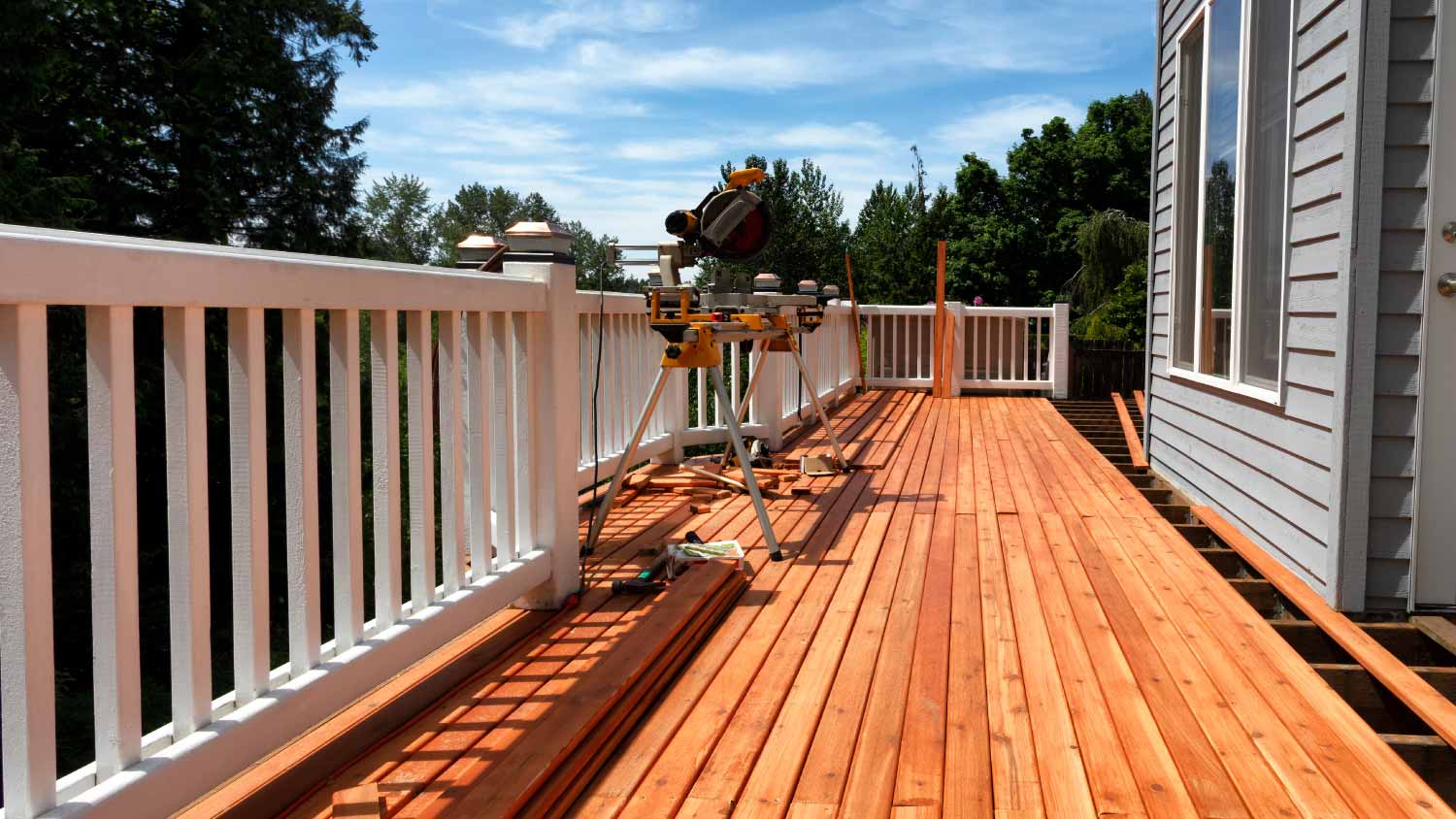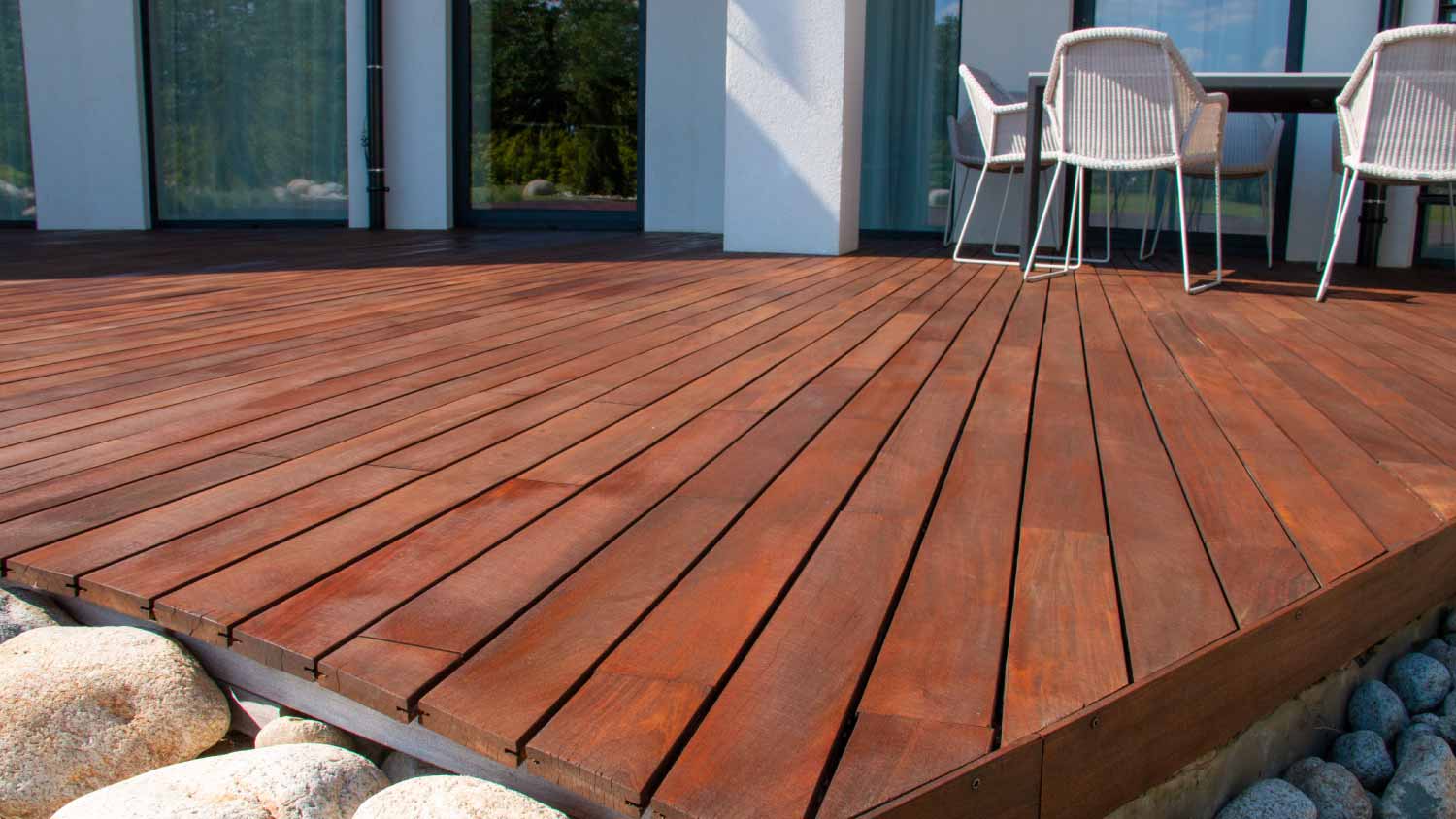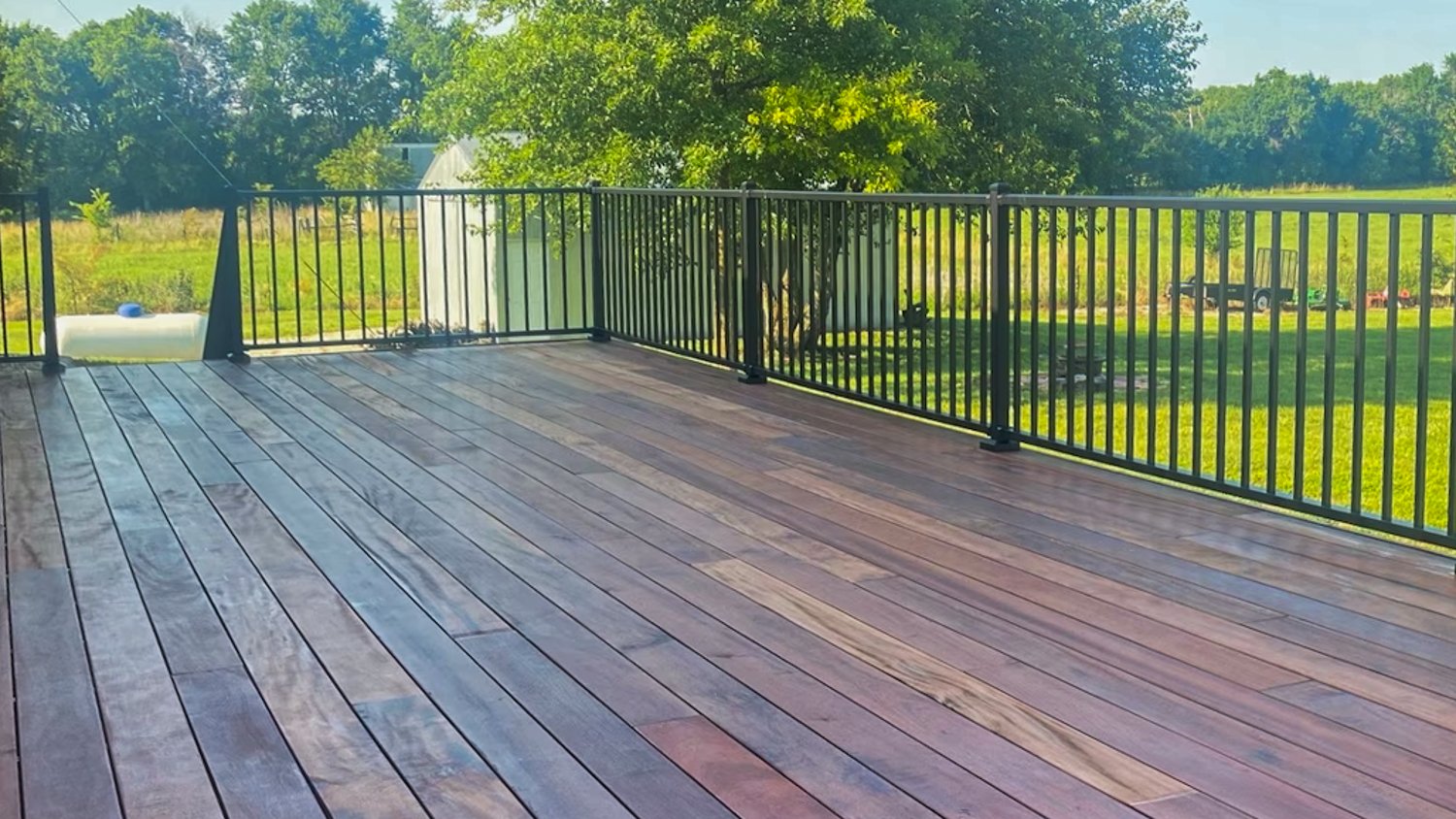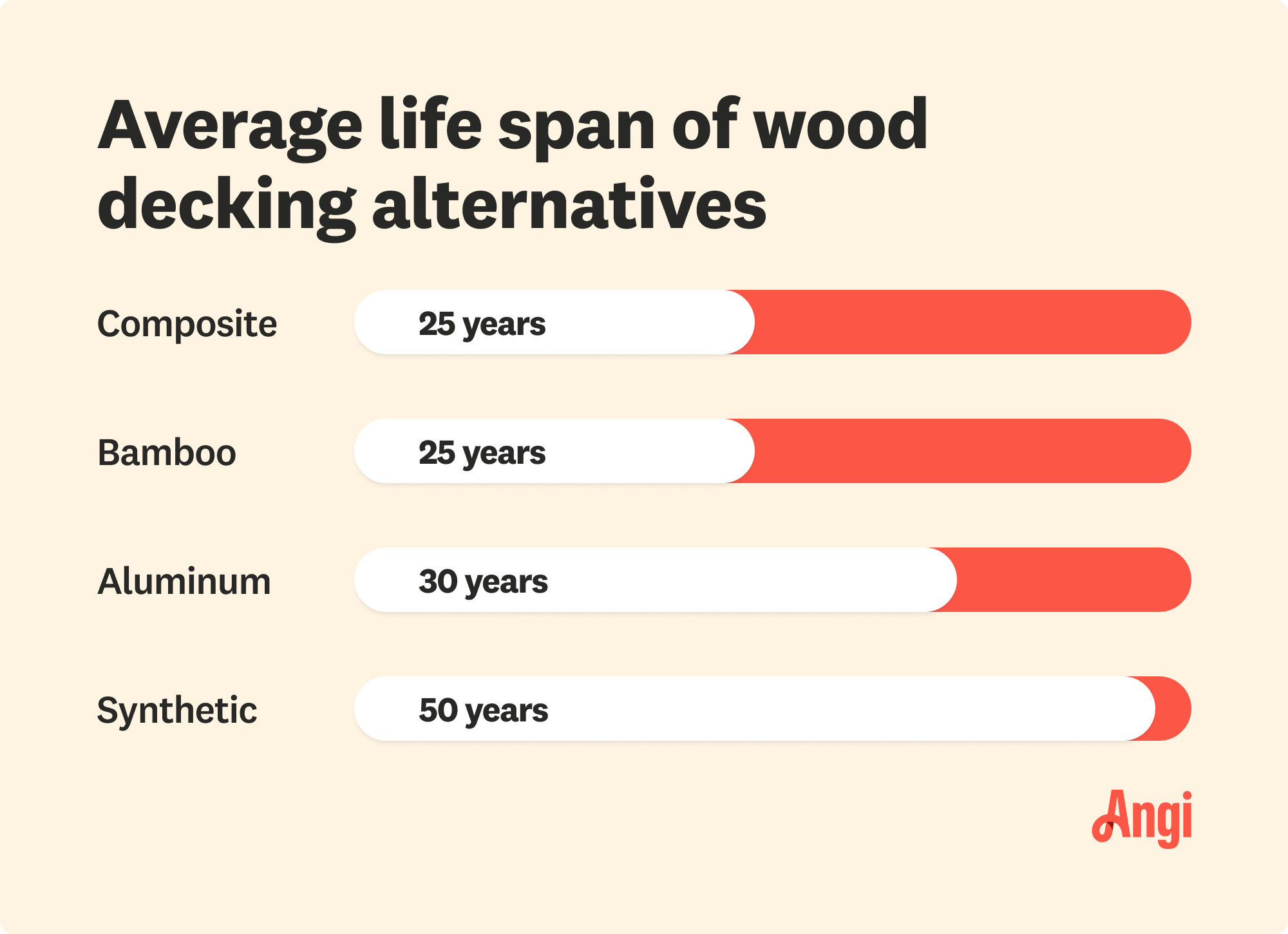
A porch can expand your living space and add curb appeal. Find out what to budget for the cost of a porch on your home with this guide.
Upgrade your outdoor space with a classic wooden deck


For some people, natural wood—whether it’s cedar, redwood, mahogany, or another type—has a timeless look that synthetic materials just can't replicate. It makes sense, then, that wooden decks are such a popular outdoor feature at many homes. But if you’re building or refurbishing a deck for the first time, how do you know which kind of wood to choose? Below, we’ve outlined the best wood for decks (in no particular order) so that you can pick the one that’s right for your project.
Building a deck is a worthwhile home improvement project that's highly likely to offer you an impressive return on investment. Remodeling by JLC's 2023 Cost Value Report found that wooden decks offer a 52.4% ROI on average, and composite decks offer a 39.8% ROI nationally.
Pressure-treated wood is a popular decking material because it contains preservatives designed to ward off insects and prevent the wood from rotting. It comes in a few different varieties, with pine being the primary one.
Because there are chemicals in this wood, it’s best to wear a mask when working with it. Also, you should avoid burning pressure-treated wood because it can release hazardous fumes when ignited.
On average, pressure-treated wood decking costs between $15 and $25 per square foot and lasts 10 to 15 years.
| Pros | Cons |
|---|---|
| Readily available in stores | Short life span |
| Customizable | Pricier than most others |
| Easy to work with | Contains chemicals |
Best for: DIY deck builders who want to get all of their supplies in one shopping trip

With its stunning reddish hue and natural wood look, cedar is an attractive and classic decking material. Even better? It’s naturally resistant to insects, rot, and moisture, which helps extend the life of your deck.
However, cedar decking requires a fair bit of maintenance to maintain its aesthetic. To prevent the cedar from losing its color, you’ll want to stain your deck every two to three years and seal it annually. This can get pretty repetitive, so it may pay off to have a pro you can trust come out to do this maintenance consistently.
For the materials alone, cedar decking costs $4 to $9 per linear foot, depending on the type of cedar you choose. Cedar decking typically lasts about 20 years.
| Pros | Cons |
|---|---|
| Rot- and insect-resistant | Needs regular maintenance |
| Classic wood look | Scratches easily |
| Relatively affordable | Not as durable as others |
Best for: People without outdoor pets aiming for a rustic-looking deck
Like cedar, redwood is another decking material recognized for its beauty, thanks to its deep red tones and stylish wood grain pattern. Plus, it repels insects and holds up well against decay and rot.
As a softwood, redwood is easier to scratch and dent than harder types of wood (like ipe). Over time, the color can fade from red into silver or gray. To keep your redwood in good condition, make sure to perform regular maintenance—including looking for any potential deck safety issues, pressure washing, staining, and sealing your deck as needed.
In terms of cost, you can expect to pay $4 to $6 per square foot for redwood decking materials. Once built, this type of deck should last around 20 years.
| Pros | Cons |
|---|---|
| Beautiful color | Color may fade |
| Repels insects | Can attract mold |
| Less expensive than other options | Easy to scuff |
Best for: Those who want an impressive-looking natural deck and don’t mind putting in the work to maintain it

Also known as Brazilian walnut, ipe is a high-end hardwood that comes from Central and South America. It’s one of the most in-demand natural decking materials—not only for its gorgeous amber color but also for its density, strength, and resistance to insects and fungi.
Ipe can be difficult to work with, so if you plan to use it for your deck, we recommend hiring a local deck builder for the job. You’ll also want to confirm that the wood was sourced responsibly because the ipe trade has been linked to issues like deforestation and illegal harvesting.
On average, ipe decking costs $5 to $20 per square foot (not including installation), putting it on the pricier end of wood decking materials. However, the cost might be worth it when you consider that ipe decking can last between 30 and 75 years.
Editor’s note: Three genera in the ipe family (Handroanthus, Roseodendron, and Tabebuia) have officially been submitted for the CITES Appendices of endangered species. Their inclusion goes into effect in November 2024, after which trade of ipe will be more strictly regulated and prices will likely increase.
| Pros | Cons |
|---|---|
| Strong and dense | Pricier |
| Long-lasting | Hard to work with |
| Repels water and insects | Not always harvested ethically |
Best for: People who want a deck so durable that it might even outlive them
Mahogany, a reddish-brown hardwood with a dense wood grain pattern, is another naturally beautiful decking material. It’s some of the best wood for decking because it’s durable, stable, and unlikely to rot or decay—all ideal qualities for decks and other outdoor structures.
Like other types of wood decking, mahogany requires some upkeep to retain its look. This includes cleaning your deck annually and staining it every couple of years.
At $8 to $11 per square foot, mahogany is a moderately priced wood decking material. With proper deck maintenance, mahogany decking can last for about 40 years.
| Pros | Cons |
|---|---|
| Deep, rich color | Can be difficult to install |
| More durable than most | Regular upkeep required |
| Rot-resistant | Higher starting price |
Best for: Anyone searching for a dark-colored wood deck with a tropical flair

Known for its unique striped pattern, tigerwood is a one-of-a-kind decking material. It comes in a range of colors, with varying hues of orange, red, and brown. As a hardwood, tigerwood is tough, long-lasting, and resistant to rot, pests, and scratches.
In terms of maintenance, tigerwood is similar to other exotic hardwoods. You’ll want to sweep and wash the deck boards regularly to keep dirt and debris from penetrating the finish. Staining will also help maintain the decking’s color.
Tigerwood decking costs between $7 and $15 per square foot, not including installation. It typically lasts around 30 years.
| Pros | Cons |
|---|---|
| Visually striking | On the pricier end |
| Lasts longer than softer woods | May lose its color |
| Resists scratches well | Has some export restrictions |
Best for: People looking for a unique decking material that stands out from the rest
Many people choose wood decking for its aesthetic appeal, but if that doesn’t matter to you, then you might prefer another type of decking that’s easier to maintain and lasts longer than wood. Here are some alternatives to consider.

Composite decking—which consists of wood and plastic—is one of the lowest-maintenance decking materials on the market. (It’s also a hot trend in decking right now.) Composite decking lasts around 25 years, which is longer than several types of wood decking, including pressure-treated wood and cedar.
At $4 to $12 per square foot, composite decking costs more to install than some types of wood decking (but there are fewer ongoing maintenance expenses). It’s also less customizable and more artificial-looking.
Synthetic decking, also known as vinyl or PVC decking, is another alternative to wood decking. It’s made from plastic, so it holds up well against scratches, fading, and water damage. It also has an impressive life span of up to 50 years.
You’ll pay between $5 and $13 per square foot for synthetic decking, so it’s more affordable than some types of wood and pricier than others.
Lightweight and waterproof, aluminum decking is ideal for pool decks and other slippery areas, as it typically has a non-skid surface to prevent falls. Aluminum decking is excellent at resisting mold and stains, and when well-maintained, it doesn't rust or split.
On average, this type of decking costs $6 to $15 per square foot and lasts up to 30 years, which is similar to tigerwood. However, aluminum decking requires far less maintenance.
Bamboo is fast-growing, lightweight, and easy to transport, making it one of the most sustainable decking materials. It's also strong and resistant to mold and rot. Like ipe, though, it's important to check that any bamboo you buy has been harvested responsibly.
Bamboo decking usually costs $3 to $10 per square foot, which is less expensive than most types of wood decking. However, like wood, it needs to be resealed regularly. With proper care, bamboo decking can last 25 years or more.
The cost to build a deck will set many homeowners back around $8,240, with an average price tag of $4,340 to $12,600, depending on the project's scope. Factors like deck height, design complexity, and material choice play a significant role. As an example, a second-story deck costs significantly more due to the added structural support and framing required.
Upgraded features, like privacy fencing, lighting, or high-end materials, can also increase what you pay dramatically, but these features can also increase your home's resale value. A well-designed deck often yields a 40% to 52% return on investment. But you can also expect your property taxes and insurance premiums to increase, so it's wise to plan for those extra expenses.
Tackling a deck build on your own might sound like a fun way to boost your DIY skills, but it can quickly turn complicated.
Professional builders know the ins and outs of local codes, permits, and zoning laws that can derail even the most confident DIYers. More importantly, they bring the know-how to handle the structural load and can ensure that details like drainage and material installation are handled correctly, directly impacting how long your deck lasts and how much value it adds to your home.
From average costs to expert advice, get all the answers you need to get your job done.

A porch can expand your living space and add curb appeal. Find out what to budget for the cost of a porch on your home with this guide.

A concrete patio adds valuable outdoor living space to your home. Learn how much a concrete patio costs and which factors affect the project price.

Thinking of adding a pergola to your backyard space? Find out motorized pergola costs by size, material, and add-on features with this guide.

If you’re preparing to build or replace a deck or porch, here are the first questions you should be asking a contractor before hiring them for the project.

Your new deck will be a welcomed outdoor living space. But what is deck flashing, and why do you need it? We discuss this important aspect of deck building.

Applying a paver sealer to your driveway or patio will give it new life. Read on for steps to help protect your hardscape from stains and damage.